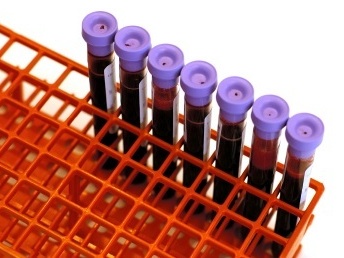Antioxidants quell tumorigenic cells
Polyploidy – an increase in the number of a cell’s whole set of chromosomes – contributes to tumor development by causing genomic instability. Elevated generation of reactive oxygen species (ROS) has also been associated with tumorigenesis, but polyploidy and elevated ROS have not previously been linked.
Now, Meejeon Roh, Ph.D., and Sarki Abdulkadir, M.D., Ph.D., report that polyploid prostate and mammary epithelial cells contain higher levels of ROS than normal diploid (two sets of chromosomes) cells, and that the elevated ROS levels are due to higher numbers of mitochondria, the main site of ROS production. The researchers demonstrated that the antioxidant N-acetyl-cysteine, which reduces ROS production, eliminated the tumorigenic potential of the polyploid cells. Longer antioxidant treatment selectively eliminated the polyploid cells, effects that were mediated in part by the Akt signaling pathway.
The findings, published in the Journal of Cellular Physiology, show that increased ROS in polyploid cells can contribute to tumorigenicity and highlight the therapeutic potential of antioxidants in cancer treatment.
— Leigh MacMillan
Sex hormone may predict death
Survival after traumatic injury may be influenced by sex hormones (estrogen and testosterone) and their effects on inflammatory processes. Previously, Addison May, M.D., and colleagues showed that high blood levels of estradiol, a form of estrogen, at hospital admission was associated with death in critically ill patients regardless of gender.

iStockphoto.com
To address how trends in estradiol over time may relate to mortality, May and colleagues measured estradiol levels in 1,408 critically ill or injured adults requiring ICU care for at least 48 hours. They report in the Journal of the American College of Surgeons that changes in blood estradiol levels in critically ill or injured adults are more strongly associated with mortality than a single estradiol measurement done at admission and outperformed other measures of inflammation.
While it remains unclear whether estradiol is contributing to disease outcome or is simply a marker of disease severity, the findings suggest that blood estradiol levels may be a clinically useful predictor of death.
— Melissa Marino
HIV drug target “trapped”
Identifying and disabling host cell factors involved in viral disease offers alternatives to traditional antiviral therapies, which typically target the viral particles themselves. A multi-institutional team including Vanderbilt researchers Donald Rubin, M.D., and Jinsong Sheng, M.D., now reports in the journal Retrovirology that the protein ADAM10 may be a potential therapeutic target for HIV infection.

iStockphoto.com
To identify host factors that influence viral survival, Rubin and Sheng randomly inserted short pieces of nonfunctional DNA into the genomes of cultured host cells – effectively turning individual genes “off” – and exposed the cells to viruses that typically kill the cell. If a cell survived the viral assault, then the disrupted gene was required for the virus to grow. Using this “gene trap” method, they found that cells in which the gene encoding ADAM10 was disrupted survived infection with reovirus.
The research team then found that silencing ADAM10 in human cells inhibited replication of HIV. The results suggest that ADAM10 represents a novel cellular target for the development of retroviral drugs.
— Melissa Marino
Magnesium affects prostate cancer risk
Several studies suggest that calcium intake or higher blood calcium increases prostate cancer risk; however, others do not agree. Magnesium plays an important role in counteracting the effect of calcium, including effects on cell proliferation and inflammation.

iStockphoto.com
Qi Dai, M.D., Ph.D., Jay Fowke, Ph.D., and colleagues investigated the importance of serum magnesium and calcium levels on prostate cancer risk in the Nashville Men’s Health Study. They found that serum magnesium levels were significantly lower – and that the ratio of calcium to magnesium was significantly higher – among men with high-grade (more aggressive) prostate cancer compared to men without prostate cancer. Serum calcium levels alone were not significantly associated with high- or low-grade prostate cancer or prostatic intraepithelial neoplasia. The researchers also report a possible racial difference in the calcium-magnesium ratio.
The findings reported in PLoS ONE suggest that magnesium affects prostate cancer risk, perhaps through its interactions with calcium, and may provide new opportunities for personalized prevention of prostate cancer.
— Leigh MacMillan
We welcome suggestions for research to highlight in Aliquots. The items should be primary research articles (no reviews, editorials or commentaries) published within the last two months in a peer-reviewed journal. Please send the article citation (PDF if available) and any other feedback about the column to: aliquots@vanderbilt.edu.
Past Aliquots
June 22, 2012
June 8, 2012
May 11, 2012
April 27, 2012
April 13, 2012
March 30, 2012
March 16, 2012













